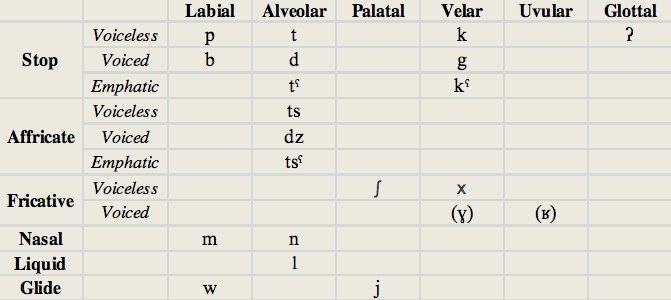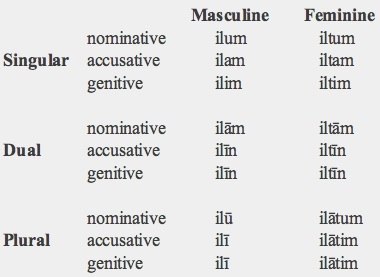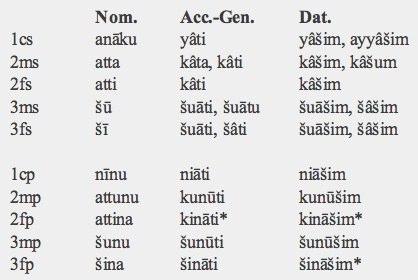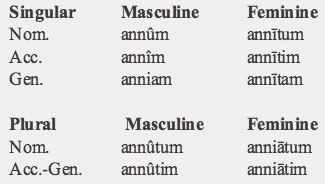An insatiable appetite for ancient and modern tongues


Name origin: Akkadian derives from Akkad, the name of an ancient city whose exact location is still unknown, founded by king Sargon in 2300 BCE as the capital of his Mesopotamian empire.
Classification. Afro-Asiatic, Semitic, East Semitic. Besides Akkadian, the East Semitic branch includes another (extinct) language, Eblaite, spoken in ancient Ebla (now in Syria).
Overview. Akkadian is the oldest written Semitic language, spoken formerly in Mesopotamia (now Irak) from the 3rd millennium BCE. In the next millennium, it evolved into northern and southern dialects, called respectively Assyrian and Babylonian. At the beginning of the first millennium, Babylonian gradually replaced Assyrian and was widely used throughout West Asia as an international vehicle for written communications. In the course of the first millennium, Aramaic displace it as a lingua franca.
Distribution. Akkadian was originally spoken in Mesopotamia, the land between the rivers Euphrates and Tigris, in what is today Iraq. It was also used as a lingua franca throughout the entire Near East.
Status. Extinct. Akkadian lasted as a spoken language between 2500 and 500 BCE but some texts continued to be written in it up to the first century BCE.
Varieties. The two main varieties of Akkadian were Assyrian, spoken in northern Mesopotamia, and Babylonian, spoken in southern Mesopotamia. They differ in phonology, morphology and vocabulary.
Periods.
2500–2000 BCE. Old Akkadian
2000–1500 BCE. Old Babylonian/ Old Assyrian
1500–1000 BCE. Middle Babylonian/ Middle Assyrian
1000–600 BCE. Neo-Babylonian/ Neo-Assyrian. During the Neo-Assyrian Empire (934-609 BCE).
600–100 BCE. Late Babylonian. After the fall of the Neo-Assyrian Empire.
Main Documents. Texts in Akkadian are abundantly attested in Mesopotamia and peripheral regions from the mid-3rd millennium onwards. They are written on thousands of clay tablets in the cuneiform logographic-syllabic system that speakers of Old Akkadian adopted from Sumerian. They are extremely varied. Most of them are economic and administrative in nature. Others are monumental inscriptions, legal documents such as the Code of Hammurabi, astronomical and mathematical texts, mythical stories, letters, etc.
Phonology
Vowels (8). Akkadian had four basic vowels with short and long varieties:

Long vowels are indicated by a macron or a circumflex accent in transcription: [a:] is rendered as ā or â, [e:] as ē or ê, [i:] as ī or î, and [u:] as ū or û. The circumflex notation is restricted to those long vowels originated by contraction of two contiguous vowels resulting from consonant loss. Vowel length is phonemic, e.g. mutum (‘husband’), mūtum (‘death’).
Consonants (20). Old Akkadian lost most of the laryngeal and pharyngeal consonants of Proto-Semitic but had three emphatic consonants (tˤ, kˤ, tsˤ) which were produced with constriction of the pharynx (pharyngealized). The sound transcribed as r was, possibly, a velar or a uvular voiced fricative (between brackets). The affricates became fricatives in Assyrian and Babylonian.
The glides as well as the glottal stop occur only between vowels. All consonants may be doubled; doubled consonants are pronounced longer.

-
Some sounds have particular transcription conventions:
-
The ‘emphatics’ are rendered: [tˤ] as ṭ, [kˤ] as q, [tsˤ] as ṣ
-
The affricates [ts] and [dz] as s and z
-
The fricatives [ʃ] and [x] as š and ḫ
-
The fricative [ɣ] or [ʁ] as r
-
The glide [j] as y
-
The glottal stop [ʔ] as ̓
Stress. It falls on the last syllable if it is heavy (ending in a long vowel or in a short vowel plus a consonant). Otherwise, on the last heavy syllable or, when there are no heavy syllables, on the first one.
Script. Akkadian was written in a cuneiform script developed from that invented by the Sumerians. It had between 200 and 400 different signs, part of which represented whole words (logograms) while others represented sounds (phonograms).
Morphology
An Akkadian word is composed of two parts: the root formed by three consonants (less frequently by two or four), and the vowels. The root gives the basic lexical meaning of the word and the vowels provide grammatical information.
-
Nominal. Nouns, adjectives and pronouns are marked for gender, number and case.
-
•number: singular, dual, plural. In Old Babylonian the dual is restricted to parts of the body.
-
•gender: masculine, feminine.
-
The masculine is unmarked while the feminine is marked by the affix -t/-at. However, some feminine nouns lack the affix marker or have it only in the plural.

-
•case: nominative, accusative, genitive, locative (rare), terminative (rare, meaning 'to, unto').
-
All nouns and adjectives have the same declension patterns; for example ilum ('god') and iltum ('goddess') shown in the table.
-
•pronouns: personal, demonstrative, interrogative, indefinite.
-
Personal pronouns are inflected for case, number and gender (except for the first person which has a single common gender form). The accusative-genitive case is used for the direct object, with an accusative or genitive noun, and after prepositions except ana (‘to, at, for’). The dative is used after the preposition ana.

-
* predicted but unattested forms.

-
Demonstrative pronouns distinguish near and far. The distant demonstrative is the same as the third person pronoun. The near demonstrative is inflected as shown in the table.
-
Interrogative pronouns are inflected in three cases but they don’t distinguish gender and number: 'who?' is mannum (nom.), mannam (acc.), mannim (gen.); 'what?' is mīnum (nom.), mīnam (acc.), mīnim (gen.). Another form of 'what?' is minûm (nom.), minâm (acc.), minîm (gen.). Ayyum ('which?') is an adjective that agrees in case, gender and number with its noun.
-
Indefinite pronouns derive from the interrogatives, by reduplication or by the addition of -ma, and are invariable: mamman or mamma ('anyone, someone'), mimma ('anything, something, all'). The adjectival ayyumma ('whichever, any, some') is declined like ayyum.
-
•articles: there are no indefinite or definite articles.
-
Verbal. The lexical meaning of the verb is conveyed by the (usually) triconsonantal root. Verbal morphology is indicated by changes in the vowels of the root combined with affixing and gemination. Verbs may be classified as: active transitive (which have a direct object), active intransitive (mostly verbs of motion but also "to live"), and stative or adjectival (to be or to become something).
-
•person and number: Akkadian verbs are inflected for person, gender and number. The person is indicated by a prefix appended to the verbal root, and gender and number by a suffix. The gender distinction is only marked in the 2nd person singular and in the 3rd person plural.
-
•mood: indicative, imperative (positive command), prohibitive (negative command), precative (positive wish), vetitive (negative wish) ventive or allative (indicates direction of motion).
-
•aspect: imperfective, perfective, perfect.
-
•tense: preterite, durative, perfect. Tense and aspect are intimately connected. The preterite has perfective aspect expressing an action that occurred at a single point in time. The durative is primarily imperfective in meaning and is used for ongoing and future actions. The perfect expresses an action that is related to another or has bearing on the present time.
-
Akkadian verbs are classified as strong or weak. The latter experience some degree of phonetic modification in the conjugation process. Besides, verbs belong to one of four systems (G, D, Š, N) comparable to the derivative conjugations of Hebrew and Arabic. What follows refers to strong verbs in the G conjugation, which is the basic one.
-
The preterite is formed by adding a ‘thematic vowel’ between the second and third consonants of the root; it can be either i, a or u. This same vowel appears in the durative and perfect of the indicative as well as in the imperative-precative and the vetitive. However, most verbs having u in the preterite have a in the durative and the perfect.
-
The durative is distinguished by a marker, placed between the first and second consonants of the verb root, with the structure -aR- (in which R is a reduplication of the second root consonant).
-
The perfect is marked by the infix -ta- placed, also, between the first and second root consonants (when the first consonant of the verb root is d, ṭ, s, ṣ, z the t of the infix is completely assimilated to it).
-
The conjugation of šarāqum (‘to steal’) is as follows:

-
black: verb root; red: thematic vowel; blue: person, number and gender markers;
-
brown: tense and mood markers.
-
Note: the thematic vowel of the perfect and the imperative drops when there is a vocalic suffix.
-
The imperative has only second person forms and its marker is a repetition of the thematic vowel placed between the first and second consonants of the root. The precative, expressing a wish or an indirect command in the first or third persons, is marked by the prefixes lu- (1cs), li- (all 3rd persons) or by the proclitic i (1cp). To express a negative command (prohibitive) the particle lā is preposed to the present. The vetitive is similar to the preterite from which is differentiated by the proclitics ay before vowels and ē before consonants.
-
The ventive is formed by adding some suffixes to any finite verb: -am for the 1st persons, 2ms and 3rd singular; -m for 2fs; -nim for the 2nd and 3rd persons plural.
-
•non-finite forms: infinitive, active participle, passive participle.
-
The infinitive has the following structure: CaCāCum (C = root consonant); for example šarāqum (‘to steal’), wasābum (‘to dwell’), marāṣum (‘to get sick’). It behaves like a noun and is declined accordingly; it frequently follows a preposition and it often functions like the English gerund.
-
The active participle behaves as, and is inflected like, an adjective or noun; it has the following structure: CāCiC. It corresponds to English adjectives ending in -ing. For example, ṣābitum (‘capturing, captor’).
-
The passive participle or verbal adjective is also inflected and corresponds to the English past participle; it has the following form: CaCC. For example, nominative masculine singular ṣabtum (‘captured’).
Syntax
In contrast to other Semitic languages, Akkadian has a strict verb-final word order, probably acquired because of Sumerian influence. Both Subject-Object-Verb (SOV) and Object-Subject-Verb (OSV) orders are common. Nevertheless, within the noun phrase, Akkadian has characteristics associated with the Semitic VO order, like modifiers following the head noun and prepositions. Attributive adjectives agree with their nouns in case, gender and number. The verb agrees with its subject in person, gender and number.
Akkadian has no verb ‘to be’ and, thus, nominal clauses (i. e. verbless) are frequent. In them, when the subject is a noun it stands at the beginning, but when the subject is a pronoun it stands at the end of the clause.
Lexicon
The Akkadian vocabulary is mostly of Semitic origin but it has a good number of loanwords from Sumerian (a non-Semitic language). In the first millennium BCE Akkadian incorporated many words from Aramaic. Besides Sumerian and Aramaic, many other languages contributed to enlarge the Akkadian vocabulary, namely various Semitic languages as well as Egyptian, Elamite, Persian, Hittite, Urartian and Greek.
Basic Vocabulary
one: ištēn (m), ište'at (f)
two: šinā (m), šittā (f)
three: šalāš (m), šalāšat (f)
four: erbe (m), erbet (f)
five: ḫamiš (m), ḫamšat (f)
six: šediš (m), šeššet (f)
seven: sebe (m), sebet (f)
eight: samānē (m), samānat (f)
nine: tišē (m), tišīt (f)
ten: ešer (m), ešeret (f)
hundred: me'atum
father: abum
mother: ummum
brother: aḫum
sister: aḫātum
son: mārum
daughter: mārtum
head: rēšum
eye: īnum
foot: šēpum
heart: libbum
tongue: lišānum
Key Literary Works (all are anonymous, all dates are BCE and approximate).
18th-15th c. Enuma Elish (The Epic of Creation)
-
Named after its opening words, Enuma Elish ("When on High"), it relates the birth of the gods triggered by the merger of the primeval waters, Tiamat and Apsu. Finally, Marduk is born who after defeating Tiamat, the embodiment of the original chaos, divides her to form the heavens and the earth, establishes the present order of the universe, and mankind is created to serve the gods. Its recitation formed part of the all important New Year festival.
-
c. 1700 Atrahasis
-
Men were created by the gods out of clay mixed with the blood of a slain god (Geshitu-e) in order to make them work on their behalf. But they multiplied so fast that a plague was caused by the gods to reduce their numbers and, later, a famine. But, thanks to the prayers of Atrahasis, the gods responsible of each of these evils relented. The god Enlil was furious and to exterminate mankind once and for all provoked a great flood. Atrahasis, forewarned by Enki, builds an ark and saves himself, his family and all the animals from destruction.
-
15th c. Adapa
-
Adapa was the first of the seven sages sent to earth to bring civilization to mankind. He was the priest of god Ea, in his temple in the city of Eridu. He angered Ea who, then, misadvised him to refuse the food of Anu, the sky-god, when he was invited to heaven. Adapa didn't accept the bread and water offered to him by Anu and lost the chance to obtain immortality.
-
8th-7th c. Epic of Gilgamesh
-
It integrates the separate Sumerian myths about the hero Gilgamesh into a single story to produce the longest and one of the greatest literary compositions in Akkadian. Two versions exist, the standard Neo-Babylonian one, dating back from the 8th-7th c. BCE, and a shorter Old-Babylonian version. The epic narrates the adventures of Gilgamesh, king of the city of Uruk, accompanied by his friend Enkidu. They killed the bull of the goddess Ishtar and as punishment Enkidu dies. Afterwards, Gilgamesh undertakes a perilous quest for immortality but in the end fails.
-
c. 1300 Ludlul Bēl Nēmeqi (The Poem of the Righteous Sufferer)
-
It is a long poem of nearly 500 lines, partially preserved, in which a noble complains about all sorts of calamities that afflicted him but was in the end saved from them by the god Marduk.
-
© 2013 Alejandro Gutman and Beatriz Avanzati
Further Reading
-
-'Akkadian and Eblaite'. J. Huehnergard & C. Woods. In The Ancient Languages of Mesopotamia, Egypt and Aksum, 83-153. R. D. Woodard (ed). Cambridge University Press (2008).
-
-'Akkadian'. G. Deutscher. In Concise Encyclopedia of Languages of the World, 20-21. K. Brown & S. Ogilvie (eds). Elsevier (2009).
-
-A Grammar of Akkadian. J. Huehnergard. Scholars Press. (1997).
-
-Introduction to Akkadian. R. Caplice & D. Snell. Editrice Pontificio Istituto Biblico (2002).
-
-Sprachen des Alten Orients. M. P. Streck. Wissenschaftliche Buchgesellschaf (2005).
-
-Grundriss der akkadischen Grammatik. W. von Soden. Pontificium Institutum Biblicum (1995).
-
-'Akkadian'. In Ancient Scripts.com: a compendium of world-wide writing systems from prehistory to today. Lawrence Lo. Available online at: http://www.ancientscripts.com/akkadian.html
Akkadian

Address comments and questions to: gutman37@yahoo.com

MAIN LANGUAGE FAMILIES
LANGUAGE AREAS
Languages of Ethiopia & Eritrea
LANGUAGES by COUNTRY
LANGUAGE MAPS
-
• America
-
• Asia
-
Countries & Regions
-
-
Families
-
• Europe
-
• Oceania